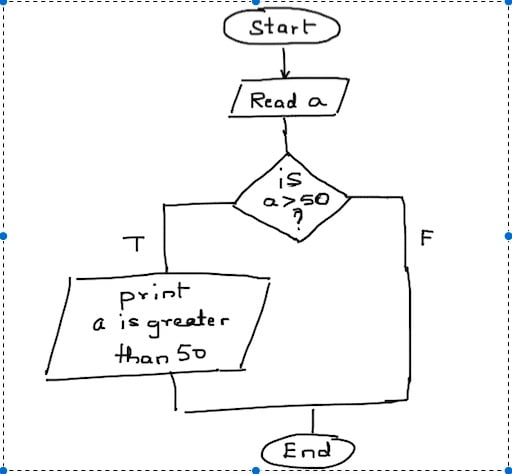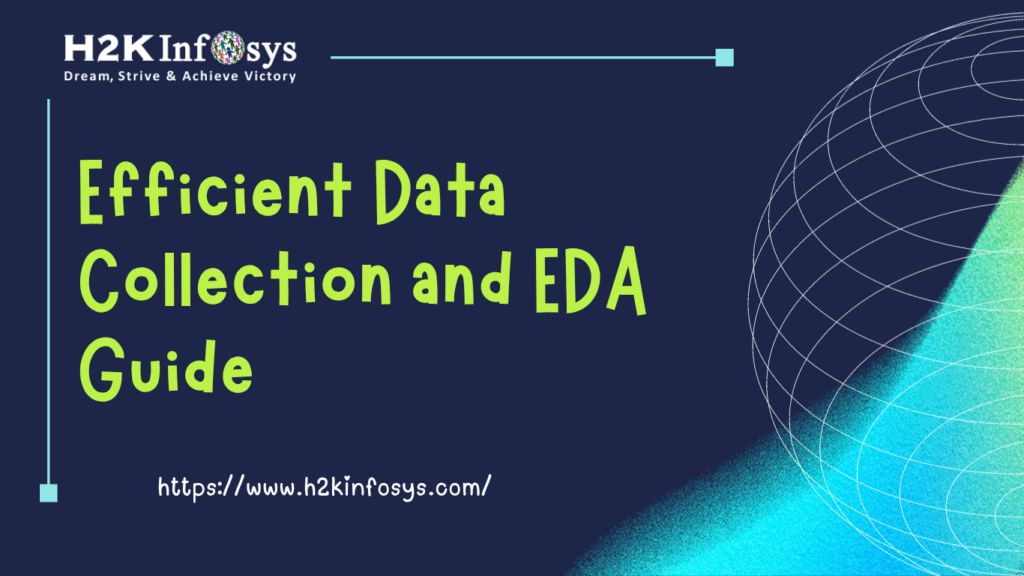Decision testing is also called branch testing. It is test design technique for white box testing. The white box testing is performed by the developers using the development tools. The programs and interfaces between the programs are tested. The white box testing is also called structural testing. There are two types of white box testing techniques:
statement testing or statement coverage
decision testing or decision coverage
Decision Testing:
The decision testing is a process which checks the behaviour of the application by providing different combinations of input and obtains various results. It is also called as Branch Testing where the different types of inputs are supplied to check a particular condition.
Example 1:
To check if a number is greater than 50
algorithm:
int a
read a
if a > 50 then
print: a is greater than 50
end if
flowchart:
Refer to the above flowchart, there are two paths: TRUE & FALSE. As per decision testing, 100% decision coverage can be achieved when all the possible paths between start to end are covered. To cover the two possible paths below data sets can be considered for testing:
a = 60 (TRUE path) , a = 50 (FALSE path)
a = 60 (TRUE path) , a = 40 (FALSE path)
Check your understanding:
1. List down the different symbols used in flowchart & their purpose































84 Responses
Symbols used in above flow chart are:
1. Oval symbol indivatess start and End.
2. Small parallelogram symbol indicates read.
3. A big parallelogram symbol indicates output.
4. A Rhombus symbol indicates validation.
5. A Rectangle symbol indicates linking of validation, output and End.
Different Symbols used in the flow chart and their purpose are:
1. Oval symbol indicates the Start and End.
2. Small Parallelogram symbol indicates Read.
3. Big Parallelogram symbol indicates Input.
4. Rhombus symbol indicates Validation.
5. Rectangle symbol indicates linking of Validation, Output and End.
1.Start/end: An oval represents a start or end point.
2.Arrows:A line is a connector that shows relationships between the representative shapes.
3.Input/Output: A parallelogram represents input or output.
4.Decision: A diamond indicates a decision.
5.Process: A rectangle represents a process
1. List down the different symbols used in flowchart & their purpose.
• An oval represents a start or end point
• A line is a connector that shows relationships between the representative shapes
• A parallelogram represents input or output
• A rectangle represents a process
• A diamond represents a decision
Ans.: Symbols used in flowchart & their purpose.
Oval- This represent the start points, end points.
Parallelogram- input/output symbol. Represent data that is available for input or output as well as a representing resources used or generated.
Diamond – decision symbol, indicates a question to be answered-usually yes/no or true/false.
Rectangle – A rectangle represent a process.
Line – A line is connector that shows relationship between the representative shape
Symbols used in the flowchart and their purpose
1. Oval represents start/end
2. Parallelogram represents input/output
3. Rectangle represents process
4. Diamond represents decision
5. Line is a connector between the representative shapes.
decision testing and branch testing is a testing method which aims to ensure that each one of the possible branches from each decision point is executed. at least once and thereby ensuring that all reachable code is executed every decision is taken each way true and false.
Oval: start or end
Arrows: Connects and shows relationship between shapes
Parallelogram: Input/Output
Rectangle: Process
Diamond: Decision.
The different symbols used in flowchart & their purpose:
*Oval-An Oval represents START/END Point.
*Arrow- Lines and arrows show the sequence of the steps, and the relationships among them.
*Parallelogram: An Parallelogram represents INPUT/OUTPUT.
*Rectangle: An Rectangle represents a PROCESS.
*Diamond: A Diamond indicates a DECISION.
Oval represents start/end
diamond represent condition
Lines/arrow -flow/connection
T means true
F means false
The different symbols and their use in flow chart
Oval it represent Start/End point
Arrow represent the direction of the steps
Parallelogram represents input/ output
Rectangle represents a process.
Diamond A Diamond indicates a Decision.
Oval is the start and end point.
The arrows represent the relationship between the shapes.
Parallelogram is the result, input/output.
Line connector, connects the the flow of the program.
T: if the decision is true/ yes.
F: if the decision is false/ no
Oval: start or end point
arrows: relationship between representative shapes
parallelogram: input/output
rectangle: process
Diamond: decision
Oval – Start and End
Parallelogram : input/output
diamond : decision/condition
Lines and Arrows : To represent connection in the program and which direction it’s flowing
Oval shape : Start & End
Parallelogram: Input /Output
Diamond: Decision or condition
T – If the condition isTrue or yes
F– If the condition is false or no
Arrow & Lines: Flow & connection
1. Oval- start and end point.
2. Arrows – shows the relationship between shapes.
3. Parallelogram- represents input or output.
4. Diamond-indicates decision.
5. T- decision is true.
6. F- decision is false.
1.. The arrows represent the line connector, shows the relationship between shapes.
2.. The parallelogram represents input or output.
3. The diamond indicated desicion.
4. T- If the decision is true.
5.Oval is the start and end point.
6. F- if the decision is false
Ans:
1 . Oval is the start and end point
2. The parallelogram represents input or output.
3. The diamond indicated decision.
4. T- If the decision is true.
5. F- if the decision is false.
Different symbols used in the flow chart and their purpose are:
1. Oval shape: Represents a start or end point.
2. Arrow: It acts as a connector that shows the relationships between the representative shapes.
3. Parallelogram: Represents input or output.
4. Rectangle: Represents a process.
5. Diamond: Indicates a decision.
The different symbols used in flow chart are :
Oval – represents start and end points
Arrow – represents the connection between the symbols
Diamond- represents what the condition is
T – represents whether the condition is true or not
F -represents whether the condition is false or not
Parallelogram- represents input/output
Oval: The start/ end of the flowchart
Parallelogram: Input and output
Diamond: Decision
Arrow: Connector
T/F: True / False.
different symbols :
Oval – start / end process
Parallelogram – represents Input / output
Diamond – represents condition
T- to check condition is True
F- to check condition is False
Oval – start and end of the flowchart
Parallelogram – is the process (Read/Print)
Diamond – statement of the decision if its T or F (true or false)
line – connects a process or statements together
T – True if it satisfies the statement in the diamond shape
F- False if it does not satisfy the statement
oval: start / end of the process
arrow: shows the connection between the flow of the program
parallelogram: input / output
rectangle: processing
Diamond : decision
T: if the condition is TRUE
F: if the condition is FALSE.
1. The Oval: An End or a Beginning
2. The Rectangle: A process step
3. The Arrow: Directional Flow
4. The Diamond: Call for a Decision
5. The Parallelogram: Data being input or output from flow
6. The Circle: Connector, flow continuing to next page
Decision Testing is done by Developers. The programs and interfaces within the programs are tested.
1. Oval represents START/END Point.
2. Rectangle-For processing/or a task
3.Arrows – shows the relationship between shapes.
4. Parallelogram- represents input or output.
5. Diamond-indicates decision.
6. T- decision is true.
7. F- decision is false.
Oval: Start and end diagram of a flow chart.
Arrow: Direction of flow in a flow chart
Diamond: Decision field where we write algorithm condition
Parallelogram: Input and output field
T: True path
F: False path
1. List down the different symbols used in flowchart & their purpose.
• An oval represents a start or end point
• A line is a connector that shows relationships between the representative shapes
• A parallelogram represents input or output
• A rectangle represents a process
• A diamond represents a decision
Oval : start and end
Arrows and LInes : show connection and flow of data
Diamond: Decision
Parallelogram: Input and output
T & F: True Path and F: False Path
Oval – Start and End of the diagram
Arrows – to show where to go after that step
Diamond – decision field
Rectangle – Result or input/output
T – the condition is marked as True
F – the condition is marked as False
Oval represents Start and End of the diagram.
Parallelogram represents the Input and output
Diamond represents Decision field
Lines and Arrows represent the path of the next step
T: True condition
F: False condition
Oval:Start and end point
Diamond:condition
T:True
F:False
Parallelogram :input or output
Arrows: connection that flows.
1. Oval is the start and end point.
2. The arrows represent the line connector, shows the relationship between shapes.
3. The parallelogram represents input or output.
4. The diamond indicated decision.
5. T- If the decision is true.
6. F- if the decision is false.
List down the different symbols used in flowchart & their purpose
Oval: Use for “Start & End” in an algorithm
Arrows: Directional
Rectangle: Use for “Input & Output” in decision testing
Diamond: Decision canvas – To verify different conditions
Greater than: to verify a superiority condition
Question mark: if it is true or false
T or F: Path selection options
Oval: Start & End of the flow chart
Parallelogram: Input /Output data
Diamond: Decision making or conditions
Arrow & Lines: Connection and flow of data
Rectangle Shape – Process
Oval or Pill Shape – Start or End
Diamond Shape – Decision
Parallelogram – Input/Output
T- true.
F- false.
• Oval: It’s represents the start and end.
• Parallelogram – Represents input/output.
• Diamond Shape – Represents a decision
• Rectangle Shape – Represents a process
• Arrow: relationship between the representative shapes.
T- if it’s true
F- if it’s flase
1.List down the different symbols used in flowchart & their purpose
• Rectangle Shape – Represents a process
• Oval or Pill Shape – Represents the start or end
• Diamond Shape – Represents a decision
• Parallelogram – Represents input/output
T-true F-false
Lines and arrows shows the direction of flow
List down the different symbols used in flowchart & their purpose
Oval is the start and end.
The arrow works as the line connector, shows the relationship between shapes.
The parallelogram represents input or output..
The diamond indicates desicion..
T- If the decision is true.
F- if the decision is false
Oval shape:It represent start and end.
Rectangle:shows the processing steps.
Diamond:Decisions
Parellelogram:Input and output.
Line and arrow:Flow and sequence of steps.
T:If decision is true.
F:If decision is false.
In statement coverage testing, 100% statement coverage is said to be achieved if all the statements are tested at least once. Meaning only the specified condition is tested once fulfilling the 100% statement coverage for the test case.
Whereas 100% decision coverage can be achieved when all the possible paths between start to end are covered. Meaning all “True or False” possible outcomes are tested to verify the behavior of the software.
ovals – start/ end
rectangles – input/output
diamond – condition
t – true to condition
F – false to condition
arrow and lines – path
1. List down the different symbols used in flowchart & their purpose
~An oval represents the start/end
~An arrow/line/flow lines is a connector which shows the relationships between different shapes.
~A parallelogram represents the input/ output or action.
~A rectangle represents the process or step.
~A diamond represents a decision.
1.Start/end: An oval represents a start or end point.
2.Arrows:A line is a connector that shows relationships between the representative shapes.
3.Input/Output: A parallelogram represents input or output.
4.Decision: A diamond indicates a decision.
5.Process: A rectangle represents a process
Oval is the start and end point
Diamond is checking the decision
T is if the condition is true
F is if the condition is false
Parallelogram is the input or output
Oval: represents Start / End
Arrow: shows the relationship between shapes
parallelogram – input/output
rectangle – process
diamond – decision
Oval: An Oval Represents:Start or End Point.
Arrow: An Arrow Represent a Connector that shows relationships btw the Representative shapes
Parallelogram: A Parallelogram Represents input or output
Rectangle:A rectangle Represents a Process
Diamond:Diamond Indicates a Decision.
T:True
F:False
Different symbols used in flowchart & their purpose:
Oval: Start/End
Rectangle: Process
Diamond: Decision
Parallelogram: Input/Output
Arrows: Shows flow or relationship between shapes
A flowchart is a diagram that shows step-by-step progression through a procedure or system especially using connecting lines and a set of conventional symbols. The different symbols of the flowchart are:
– The oval is used to represent the start and end of a process
– The rectangle shows any step in the process
– The arrow is used to show the direction of the steps followed.
– The diamond symbolizes that a decision needs to be made.
– T – the condition is marked as True
– F – the condition is marked as False
1. List down the different symbols used in flowchart & their purpose
Oval – Start and end of a program
Rectangle – Input/output
Arrow – flow of the algorithm pathways
Diamond – decision split the flowchart sequence into multiple paths (True or False) in order to represent selection and repetition.
Oval-Start and End
Input/Output-Parallelogram
Diamond-Decision
Rectangle-Process
Arrow-connector
1. List down the different symbols used in flowchart & their purpose
1. Oval represents start/end
2. Parallelogram represents input/output
3. Rectangle represents process
4. Diamond represents decision
5. Line is used as a connector between the symbols.
The different symbols used in flowchart & their purpose:
Arrows- Acts as connectors of all other symbols.
Oval- To indicate the entry and exit points of the flowchart
Rectangle-To show processing steps like calculations or an action to be performed.
Parallelogram-To accept an input or display an output.
Diamond- Decision making step. Generally there are two outward connectors from this symbol. The path is chosen based on the decision of the logical computation.
Circle-If a flowchart does not fit in the available space, and needs to be broken at a point. An alphanumeric symbol within circle can be used as breaking and continuing symbol for that chart.
List of the different symbols used in flowchart & their purpose are-
1.Oval is the entry and exit point.
2.Arrow-Sequence of the steps and relationship among them.
3.Paralelogram-Input and output of the program.
4.Diamond shape-Decision in the algorithm.decision ask a question,the answer to the question determine which arrow alllow you follow out of decision shape.
5.Rectangle-It is used to show process,task,action or operation.
6.T-If the decision is true.
7.F-If the decision is false.
White Box testing is a Structural testing.
oval- stat point and end point
rectangle – data input or output
diamond- condition, if function
T-True
F-False
arrow – show the flow/order of info/ actions/ instruct to go
In the flow chart
1. The parallelogram represents input or output.
2. The diamond indicated decision.
3. T- If the decision is true.
4. F- if the decision is false.
Oval is the start and endpoint
Start and End is shown in an oval shape
If a statement is put inside a diamond shape
Execution procedure for a true statement is i a parallelogram
Arrows are shown to show the flow of the program
Like · Reply · 1w
in the flow chart
1. The parallelogram represents input or output.
2. The diamond indicated decision.
3. T- If the decision is true.
4. F- if the decision is false.
5.Oval is the start and endpoint
T= True
F= False
> = greater than
= = equals
It’s Conditional statement if the condition is true it will print the result else it will END.
Representation of flow chart diagram.
–START and END statement will be in ovel shape.
–Condition will show in Diamond shape Ex: if a>50.
–Print or Input statement will show in rectangle of square shape.
–Body of the statement will be square shape or its close circuit completed by the TRUE or FALSE condition.
Oval: start or end
Arrows: Connects and shows relationship between shapes
Parallelogram: Input/Output
Rectangle: Process
Diamond: Decision.
Different symbols used in flowchart & their purpose:
Ovals: indicate start & end of flowchart.
Parallelograms: input & output data
a: is integer
>: greater than symbol
?: question mark
Diamond: decision making dialogue box
T: for true path
F: for false path
Arrows: showing direction of flow of chart
Different symbols used in flowchart & their purpose:
-Ovals: indicate start & end of flowchart.
-Parallelograms: input & output data
-a: is integer
->: greater than symbol
-?: question mark
-Diamond: decision making dialogue box
-T: for true path
-F: for false path
-Arrows: showing direction of flow of chart
Ovals show the start and end step. Lines point to the next steps, contained in parallelograms. Decision points are in diamonds. T and F stand for true and false, the possible choices in the graph.
1. Oval represents START/END Point.
2. Rectangle-For processing/or a task
3.Arrows – shows the relationship between shapes.
4. Parallelogram- represents input or output.
5. Diamond-indicates decision.
6. T- decision is true.
7. F- decision is false.
1. Oval represents start/end
2. Parallelogram represents input/output
3. Rectangle represents the process
4. Diamond represents a decision
5. Line is used as a connector between the symbols.
List down the different symbols used in flowchart & their purpose?
A is input variable
50 is a constant variable
Decision testing:
Decision testing is also called as branch testing which is a testing technique of white box testing. Decision testing is a process which checks the behavior of the application by providing different combination of inputs and obtaining various results.
Oval – Start and end
Arrows – flow of the program
Diamond – Choice of decision of the output
Rectangle – Result
Parallelogram – Input action
T- True
F- False
1. List down the different symbols used in flowchart & their purpose
Oval – start/end
Arrow – shows relationship between the shapes
Diamond – Decision
Parallelogram – input/output
The different symbols used in flowchart and their purpose;
Oval – An oval represents start and end point.
Arrows- Flow of diagram
Diamond- Choice of decision of the output
Rectangle- Result
Parallelogram-input action
T – correct path
F – false path
List down the different symbols used in flowchart and their purpose
oval represents the start and end
Diamond represents the decision made
Parallelogram represents input /output
Rectangle represents process
Arrow represents connector
1. List down the different symbols used in flowchart and their purpose.
*Oval is start or end
* Parallelogram-input and output
* Rectangle- process
*Diamond- decision
*Arrow- relationship between symbols
1. List down the different symbols used in flowchart & their purpose.
Oval : It use to represent start and end of a process.
Rectangle : Represents Process.
Parallelogram : Represents input/output.
Diamond : Decision making dialogue box.
5. Oval = start and finish
Diamond = decision
Parallelogram = input and output
T = True F=False
Arrows are the sequences;
>= greater than
<= less than
5. Oval= start and end
Parallelogram = input and output
Diamond = decision
T = true
F = False
> = greater than
<= less than
1. List down the different symbols used in flowchart & their purpose.Oval represents as start or end
An oval represents Start and End of a process
A parallelogram represents input or output
A diamond indicated decision
1. Oval ->start and end point
2. Parallelogram -> input or output.
3. Diamond -> decision.
Different shapes used in this program :
Oval – Start
Parellellogram -Inputs
Diamond – Condition
Big parellellogram – Output
Oval – End
The symbols used in flowchart & their purpose are:
· T or F- True and False which are different paths in the flow charts.
· a > 50 which is in diamond shape is decision making.
· Rectangle which is used for whole data to test.
· Direction of flow is an arrow.